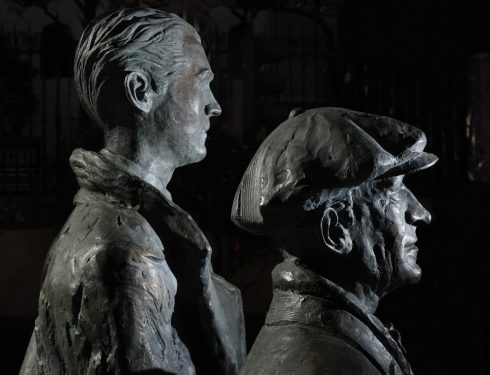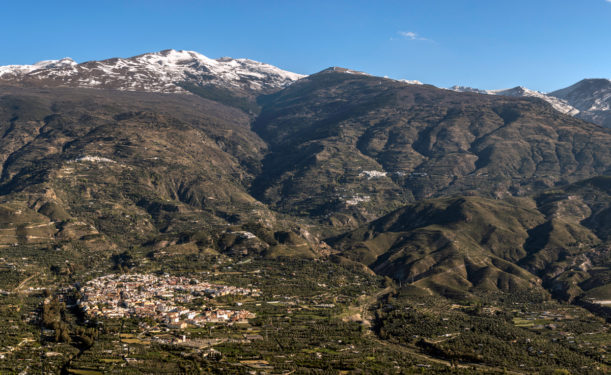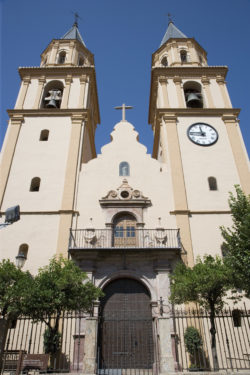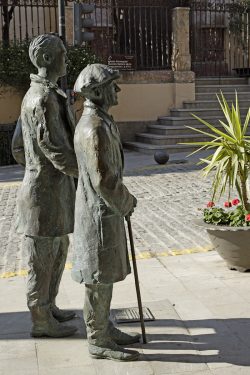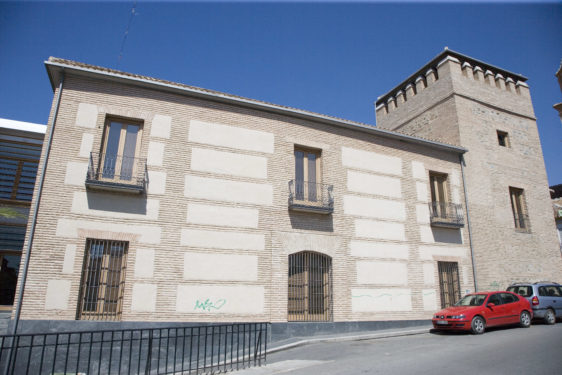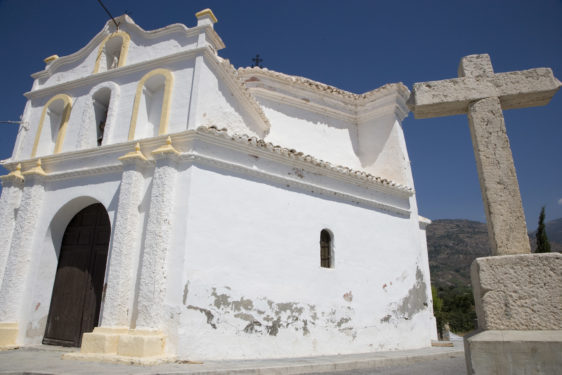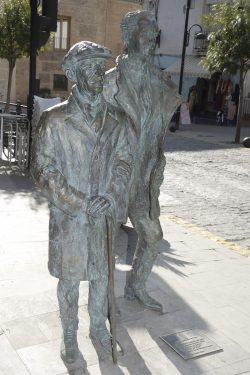The Lorca family took advantage of the annual stays in Lanjarón to tour part of the Alpujarra. They visited Órgiva, Cáñar, Carataunas and Pitres, sometimes with Falla and other friends.
The attractiveness of the Alpujarra and its inhabitants seduced Federico García Lorca very early on. Although there is no documented evidence, the poet’s travels through the region began in his formative years. The earliest graphic testimony corresponds to 1918: Federico, wearing a cap, appears on the roof of the bus that traveled the route between Granada and Motril through Órgiva, one of the capitals of the Alpujarra region. The same 20-year-old Federico, perhaps on the same excursion, appears in another image taken, according to the handwritten signature, in Órgiva next to a tree that he identifies as an orange tree. On the back of the photo, addressed to his family, he writes: “Segura [José Manuel Segura Soriano] wanted to photograph me with a flat hat and shotgun. Naranjo located at an altitude of 2,000 meters. From here I can see Soportújar, Láujar, Vallacar [sic] and Cáñar. I hear the singing of four rivers tumbling down to the olive trees of the Vega de Órgiva.”
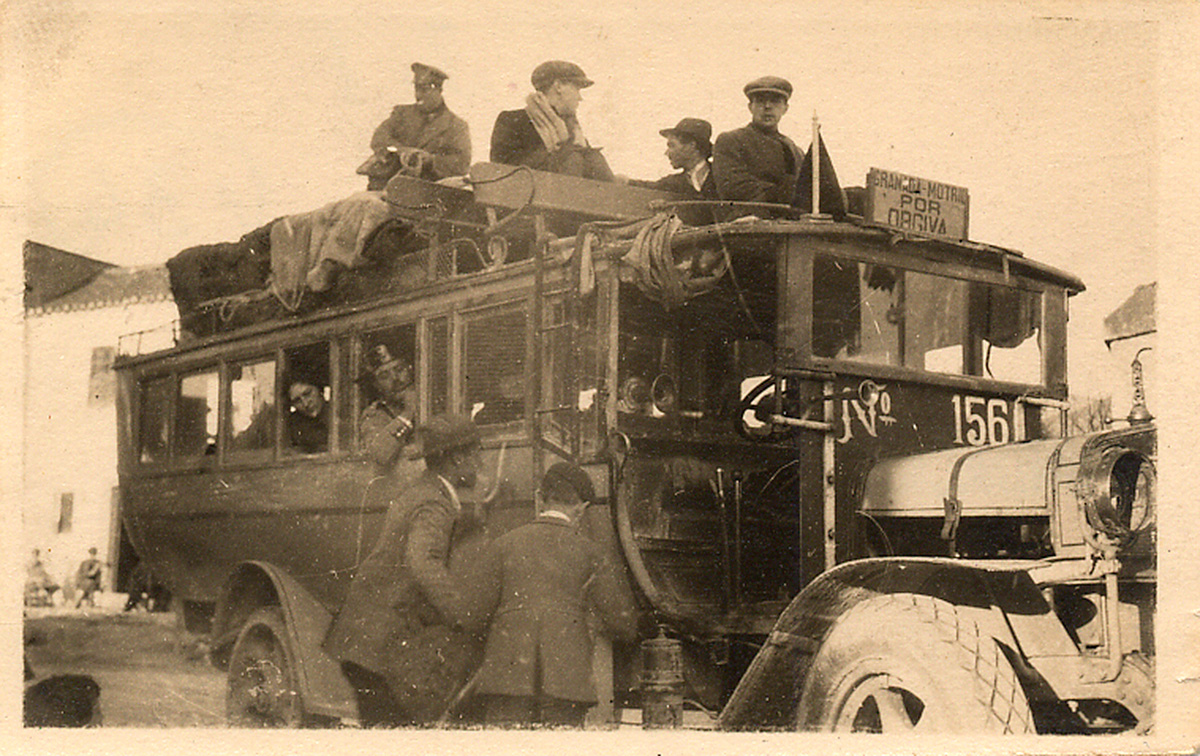
Lorca transmitted to his friends his wonder at the Alpujarra. In the summer of 1922, he proposed to Manuel de Falla to organize puppet shows in the Alpujarra: “I am enthusiastic about the project of traveling to the Alpujarra. You know how much I want to make some Cristobical [sic] full of Andalusian emotion and exquisite popular sentiment […]. If we go to the Alpujarra, we will also have to take with us some Moorish affair, which could be that of Aben-Humeya.”
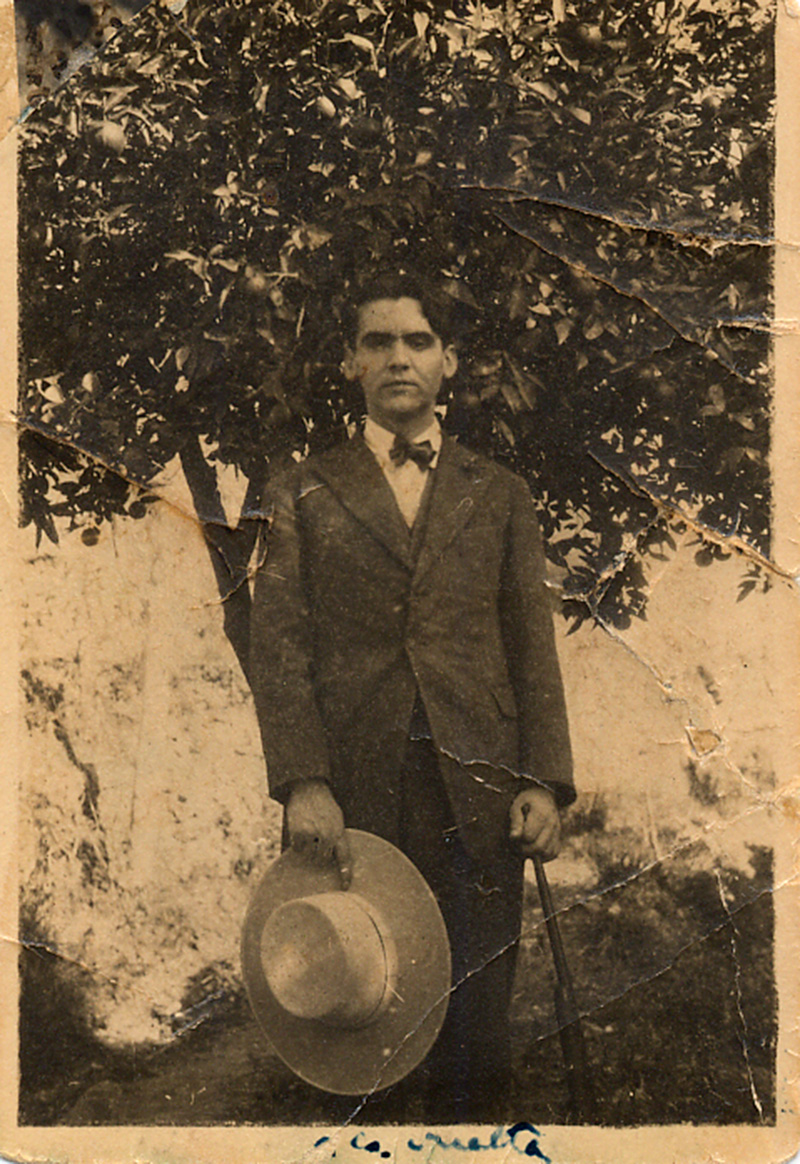
The excursion of Falla and Lorca and a group of friends to the Alpujarra had to wait until the beginning of January 1926, coinciding with the Christmas holidays. José Manuel Segura Soriano, professor of International Law; the diplomat and professor Antonio de Luna, and the lawyer Rafael Aguado Martín-Montijano traveled with them. They arrived in Órgiva in a luxurious convertible that everyone called in French landeau, that is, a vehicle with a body similar to the landó, the old horse-drawn carriage. Its owner was José de Luna, lawyer, liberal politician and father of Antonio.
There is no written record of the itinerary they followed during Lorca and Falla’s fleeting stay in the Alpujarra, although a few photographs have survived showing the group in some recognizable spots. The most notorious, the photo of the Horno Square in Órgiva. Antonio de Luna, Manuel de Falla, Lorca and José Manuel Segura appear surrounded by a large group of children next to a fountain that has known several locations and is still dismantled.
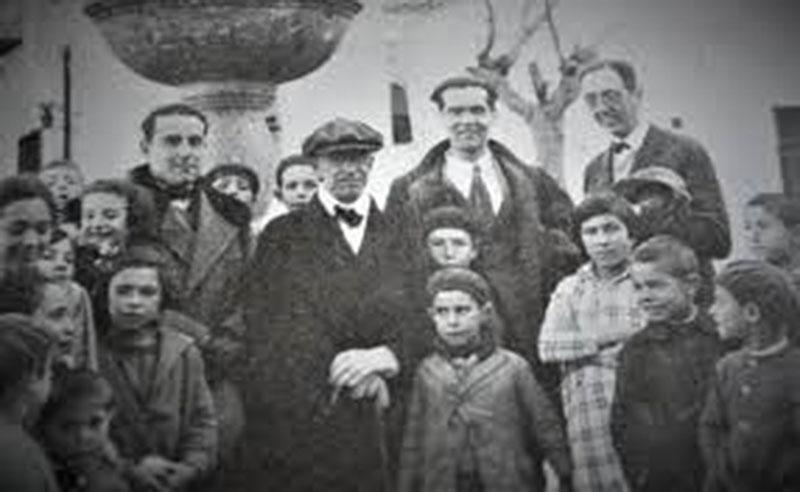
Another of the places visited by the excursionists aboard their impressive automobile was the Haza del Lino. Three photos have survived from the presence of all of them in this spot, which had impressive views. They missed another illustrious visitor by a few days: at the end of that same month of January King Alfonso XIII traveled to the Alpujarra.
Los caballos negros son.
[Black are the horses,]
Las herraduras son negras.
[their horses are shod in black.]
Sobre las capes relucen
[On their capes glitter]
manchas de tinta y de cera.
[stains of ink and wax.]
Tienen, por eso no lloran,
[This is why they do not weep:]
de plomo las calaveras.
[their skulls are cut in lead.]
Con el alma de charol
[They ride the highways]
vienen por la carretera.
[with patent leather souls.]
Jorobados y nocturnos,
[Hunchbacked and nocturnal,]
por donde animan ordenan
[they ride forth and command]
silencios de goma oscura
[the silences of dark rubber]
y miedos de fina arena.
[and the fears like fine sand.]
Pasan, si quieren pasar,
[They go where they want,]
y ocultan en la cabeza
[and hide in their skulls]
una vaga astronomía
[vague astronomical ideas,]
de pistolas inconcretas.
[amorphous pistols.]
¡Oh ciudad de los gitanos!
[Ai, city of gypsies!]
En las esquinas banderas.
[Corners hung with colors.]
La luna y la calabaza
[The moon and pumpkins]
con las guindas en conserva.
[and cherries in sweet preserve.]
¡Oh ciudad de los gitanos!
[Ai, city of gypsies!]
¿Quién te vio y no te recuerda?
[Who could see you and not recall?]
Ciudad de dolor y almizcle,
[City of musks and agony,]
con las torres de canela.
[city of cinnamon towers.]
Cuando llegaba la noche,
[As the night was approaching]
noche que noche nochera,
[the night so deep, dark, nightish,]
los gitanos en sus fraguas
[the gypsies at their forges]
forjaban soles y flechas.
[were hammering suns and arrows.]
Un caballo malherido,
[A deeply wounded stallion]
llamaba a todas las puertas.
[knocked at each door.]
Gallos de vidrio cantaban
[Glass cocks were crowing]
por Jerez de la Frontera.
[in Jerez de la Frontera.]
El viento vuelve desnudo
[The naked wind, turning]
la esquina de la sorpresa,
[in the silver night, around]
en la noche platinoche
[the corner with surprise,]
noche, que noche nochera.
[in the night so deep, dark, nightish]
La Virgen y San José,
[The Virgin and Saint Joseph]
perdieron sus castañuelas,
[have lost their castanets.]
y buscan a los gitanos
[They are looking for the gypsies]
para ver si las encuentran.
[to see if they can help find them.]
La Virgen viene vestida
[Here comes the Virgin, dressed]
con un traje de alcaldesa
[just like the mayor’s wife]
de papel de chocolate
[in silvery chocolate paper,]
con los collares de almendras.
[with a necklace of almonds.]
San José mueve los brazos
[Saint Joseph swings his arms]
bajo una capa de seda.
[beneath a cloak of silk.]
Detrás va Pedro Domecq
[Behind comes Pedro Domecq]
con tres sultanes de Persia.
[and three Persian sultans.]
La media luna soñaba
[The half moon dreamed]
un éxtasis de cigüeña.
[out an ecstasy of the stork.]
Estandartes y faroles
[And ensigns and lanterns]
invaden las azoteas.
[stormed the roof tiles.]
Por los espejos sollozan
[Hipless dancers sob]
bailarinas sin caderas.
[in every mirror.]
Agua y sombra, sombra y agua
[Water and shadow, shadow and water]
por Jerez de la Frontera.
[in Jerez de la Frontera.]
¡Oh ciudad de los gitanos!
[Ai, city of gypsies!]
En las esquinas banderas.
[Corners hung with colors.]
Apaga tus verdes luces
[Quell your green lights:]
que viene la benemérita.
[for here come the Civil Guard.]
¡Oh ciudad de los gitanos!
[Ai, city of gypsies!]
¿Quién te vio y no te recuerda?
[Who could see you and not recall?]
Dejadla lejos del mar, sin
[Let her be, far from the sea,]
peines para sus crenchas.
[with no combs to hold back her hair.]
Avanzan de dos en fondo
[To the celebrated city]
a la ciudad de la fiesta.
[they ride two abreast.]
Un rumor de siemprevivas
[The gossip of the everlasting]
invade las cartucheras.
[invades their cartridge belts.]
Avanzan de dos en fondo.
[They ride two abreast.]
Doble nocturno de tela.
[A night of twin shadows in cloth.]
El cielo, se les antoja,
[The sky, they conclude,]
una vitrina de espuelas.
[a window full of spurs.]
La ciudad libre de miedo,
[The city, unsuspicious,]
multiplicaba sus puertas.
[unfolding its doors.]
Cuarenta guardias civiles
[40 Civil Guards, to sack]
entran a saco por ellas.
[and burn, poured through.]
Los relojes se pararon,
[The clocks stopped and the brandy]
y el coñac de las botellas
[bottles impersonated November]
se disfrazó de noviembre
[so as not to stir any suspicion.]
para no infundir sospechas.
[Up rose from the weathercocks]
Un vuelo de gritos largos
[a series of long screams.]
Los sables cortan las brisas
[Sabers slashed the air,]
que los cascos atropellan.
[trampling under black horse hoof.]
Por las calles de penumbra
[Old gypsy women tried to flee]
huyen las gitanas viejas
[through the half-lit streets]
con los caballos dormidos
[with their benumbed horses]
y las orzas de monedas.
[and enormous crocks of coins.]
Por las calles empinadas
[Up the palisade streets]
suben las capas siniestras,
[climbed the sinister capes]
dejando atrás fugaces
[leaving behind brief]
remolinos de tijeras.
[whirlwinds of scissors.]
En el portal de Belén
[In the gate of Bethlehem]
los gitanos se congregan.
[all the gypsies gathered.]
San José, lleno de heridas,
[Saint Joseph, mortally wounded,]
amortaja a una doncella.
[laid a shroud upon a girl.]
Tercos fusiles agudos
[Sharp and stubborn, rifle]
por toda la noche suenan.
[bursts rang through the night.]
La Virgen cura a los niños
[The Virgin healed children]
con salivilla de estrella.
[with spit from a fallen star.]
Pero la Guardia Civil
[But the Civil Guard]
avanza sembrando hogueras,
[advance, sowing flames,]
donde joven y desnuda
[where young and naked]
la imaginación se quema.
[imagination is burnt out.]
Rosa la de los Camborios,
[Rosa of the Camborios]
gime sentada en su puerta
[moans in her doorway,]
con sus dos pechos cortados
[with her two severed breasts]
puestos en una bandeja.
[lying on a tray.]
Y otras muchachas corrían
[And other girls ran]
perseguidas por sus trenzas,
[chased by their tresses]
en un aire donde estallan
[through air where roses]
rosas de pólvora negra.
[of black gunpowder burst.]
Cuando todos los tejados
[When all the roofs]
eran surcos en la sierra,
[were furrows in the earth]
el alba meció sus hombros
[the dawn heaved its shoulders]
en largo perfil de piedra.
[in a vast silhouette of stone.]
(Gypsy Ballads, 1927)
(Ballad of the Civil Guard)- Arredondo Valenzuela M. García Lorca in Lanjarón. A Poet and a Landscape, included in Lanjarón, Water Landscapes. Lanjarón Spa, 1999.
- Adoración Elvira Rodríguez and Fernando Rubio Muñoz. Lorca in the Country of Nowhere (Lanjarón-Alpujarra), 2017.
- Federico García Lorca. Complete Works I and IV. RBA-Instituto Cervantes. Madrid, 2006.
- Isabel García Lorca. My Memories. Tusquets. Barcelona, 2002.
- Juan González Blasco. Órgiva. Milestones in his History. Volume II. Hermanos Gallego Hódar Publishing House. Órgiva, 2001.
- Lorca´s location
- Órgiva
- current location
- Órgiva
- Web
- https://www.turgranada.es/en/municipio/orgiva/
